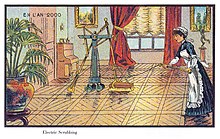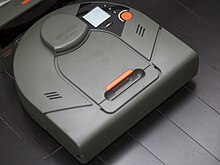
A vacuum cleaner, also known simply as a vacuum, is a device that uses suction, and often agitation, in order to remove dirt and other debris from carpets and hard floors.

Electrolux AB is a Swedish multinational home appliance manufacturer, headquartered in Stockholm. It is consistently ranked the world's second largest appliance maker by units sold, after Whirlpool.

Roomba is a term that refers to a series of autonomous robotic vacuum cleaners made by the company iRobot, and was first introduced in September 2002. Roombas have a set of sensors used to help them navigate the floor area of a home. These sensors can detect the presence of obstacles and steep drops.
Robotic mapping is a discipline related to computer vision and cartography. The goal for an autonomous robot is to be able to construct a map or floor plan and to localize itself and its recharging bases or beacons in it. Robotic mapping is that branch which deals with the study and application of ability to localize itself in a map / plan and sometimes to construct the map or floor plan by the autonomous robot.

iRobot Corporation is an American technology company that designs and builds consumer robots. It was founded in 1990 by three members of MIT's Artificial Intelligence Lab, who designed robots for space exploration and military defense. The company's products include a range of autonomous home vacuum cleaners (Roomba), floor moppers, and other autonomous cleaning devices.

Scooba was a floor-scrubbing robot made by iRobot. It was released in limited numbers in December 2005 for the Christmas season, with full production starting in early 2006. The company introduced a lower-priced version, the Scooba 5800, in the second half of 2006. It introduced a new Scooba 450 at CES 2014 in January 2014.

The Electrolux Trilobite is a robotic vacuum cleaner manufactured by the Swedish corporation Electrolux. It takes its name from the extinct arthropod, which scoured the ocean's floor.
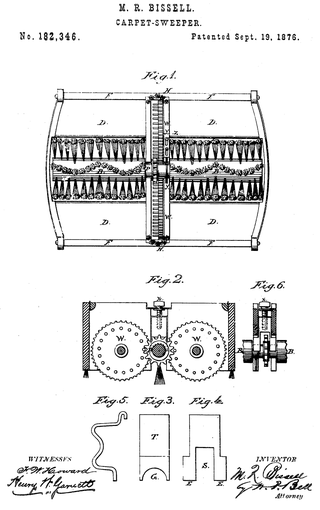
A carpet sweeper is a mechanical device for the cleaning of carpets. They were popular before the introduction of the vacuum cleaner and have been largely superseded by them. However, they continue to be used in many home and commercial applications because they are lightweight and quiet, enabling users to quickly clean small messes up from the floor without disturbing patrons, patients, babies and pets, and because they do not require electricity to operate.
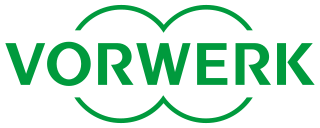
Vorwerk & Co. KG, trading as Vorwerk, is an international diversified corporate group headquartered in Wuppertal, Germany. Vorwerk was founded in 1883. The main business is the direct distribution of various products like household appliances such as Thermomix, a kitchen appliance, and Kobold vacuum cleaners, fitted kitchens and cosmetics.
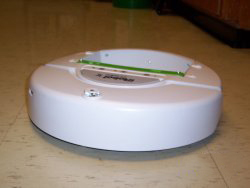
iRobot Create is a hobbyist robot manufactured by iRobot that was introduced in 2007 and based on their Roomba vacuum cleaning platform. The iRobot Create is explicitly designed for robotics development and improves the experience beyond simply hacking the Roomba. The Create replaces its Roomba predecessor's vacuum cleaner hardware with a cargo bay that also houses a DB-9 port providing serial communication, digital input & output, analog input & output, and an electric power supply. The Create also has a 7-pin Mini-DIN serial port through which sensor data can be read and motor commands can be issued using the iRobot Roomba Open Interface (ROI) protocol.

Evolution Robotics was an American technological company based in Pasadena, California. It specialized in robotics technologies, with computer vision, localization, and autonomous navigation products.
Dustbot was a prototype robot that collected garbage from homes and streets. It could be summoned by phone call or SMS, and used GPS to automatically make its way to the customer, collect the rubbish, and take it to a dustbin. In addition, the Dustbots carried environmental sensors to monitor the pollution levels over, for example, a pedestrian area. Prototypes were tested in Italy, in Sweden, in Korea and Japan. Launch was planned in 2009, but the last reference in its webpage dates from 2011. The Dustbot project was funded by the European Commission and it never launched as a commercial product.

A domestic robot is a type of service robot, an autonomous robot that is primarily used for household chores, but may also be used for education, entertainment or therapy. While most domestic robots are simplistic, some are connected to Wi-Fi home networks or smart environments and are autonomous to a high degree. There were an estimated 16.3 million service robots in 2018.

Roboking is an automated robotic vacuum cleaner produced by LG. The first version of the Roboking was launched during 2001. It is also sold as Hom-Bot. As of 2011, it is the quietest vacuum cleaner robot on the market, producing 48 decibels (dB).
The Kärcher RC 3000 was a robotic vacuum cleaner created by Kärcher in 2002, and manufactured until January 2015. Unlike other robotic vacuum cleaners of the time, the RC 3000 was designed with a self-service station that allows owners to keep their robots running for longer periods of time. The service station, containing a paper bag, accomplishes this by acting as the collection point for the dirt and dust swept up by the robot.
Ecovacs Robotics is a Chinese technology company. It is best known for developing in-home robotic appliances. The company was founded in 1998 by Qian Dongqi and is headquartered in Suzhou, China. According to Global Asia, Ecovacs Robotics had more than 60% of the Chinese market for robots by 2013. In 2023, Nikkei Asia had reported that the market capitalisation of Ecovacs Robotics has grown to near $6.38 billion, which is "roughly 5 times" that of the market capitalisation of rivalling US based iRobot, who manufactures the Roomba.
Xiaomi Smart Home Products are products released by third-party manufacturers who have partnered with Xiaomi. These products are managed by Xiaomi Home app.
Roborock is a Chinese consumer goods company known for its robotic sweeping and mopping devices and handheld cordless stick vacuums. Xiaomi played a key role in the company's founding.
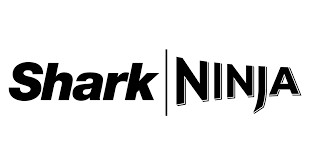
SharkNinja, Inc. is a Chinese product design and technology company based in Needham, Massachusetts. Founded in 1994 by Mark Rosenzweig and led by CEO Mark Barrocas, who joined the company in 2008 as President, the company's name is formed by combining its two primary brands: Shark and Ninja.

